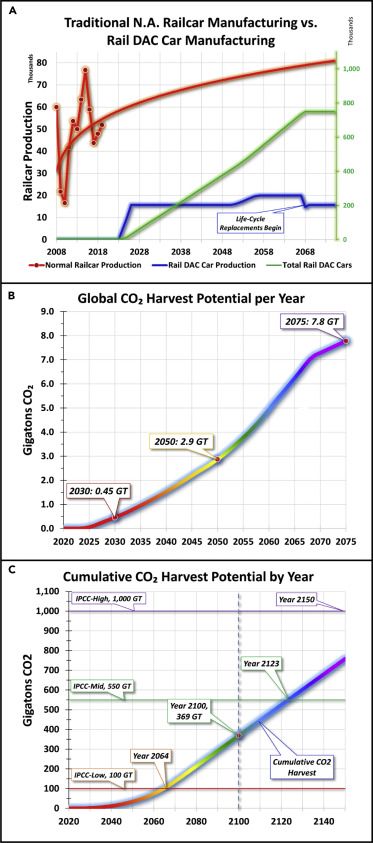In 10 seconds? Researchers are proposing an upgraded idea to slow global warming: using trains – alongside carbon capture plants - to sequester CO2 from air. According to a study the tech would be much cheaper than existing methods.
What’s the story? A team of scientists came up with the idea to upgrade freight and passenger train cars with huge vents and a filtering mechanism to suck out thousands of tons of CO2 from the air and turn our trains into rolling carbon capture plants.
Why is carbon capture important? Isn’t it enough to reduce CO2-emissions? To reach the international goal of limiting global warming to 2 °C by the end of the century, it’s not enough to cut our overall CO2-emissions, we also need to reduce the concentration of the greenhouse gas in the atmosphere. Therefore, researchers have been racing to find possibilities of sequestering CO2 in recent years and have already come up with some solutions – for example, in the shape of ‘carbon capture plants’. Sequestered carbon can be stored in rock formations, for example in Iceland. Or, it can be further used in industry for renewable fuels, chemical products and even carbonating beverages. Now, it seems some researchers have found the right track - pardon the pun - so, the sparkling water served in your train could soon be made with the CO2 captured by the same train!
What a refreshing idea… but would it work, and if so, how? The whole idea is based on the fact that this solution would “piggyback” onto something that we are using anyway - trains. Note: one of the authors is involved in a start-up making money out of this technology. The design involves fitting cars with two huge vents, one for sucking in the CO2-heavy air and the other to release the air without it. In between, a filtering system would capture and then compress and liquefy the gas, which could be stored underground or used in industrial processes. The trains draw power using a technology already present in electric and hybrid cars – regenerative braking – to use the energy generated during slowing down and stopping.

I get it but why use trains? There are already carbon capture plants, no? OK, so CO2 in the air is in concentration of about 420 ppm. To effectively capture it, huge amounts of air need flow through the capturing materials. In stationary plants, big ventilation systems are used to achieve this, whereas the train is much more effective by just moving the capture system on its way from A to B. Another problem of carbon capture is the high energy needed for the process. The idea in case of the train-based system is to use the currently unused heat generated by the brakes. Therefore, additional energy consumption can be avoided and the energy produced during breaking can ultimately be used – lowering the train’s carbon footprint.
Won’t this affect rail traffic? I mean, probably need to build new trains for this… The interesting part about the train-based carbon capture system is that it is universally useable on both electrified and diesel-powered lines. After some technical adaptations, you can install it onto currently used trains. So, in principle no new trains are needed for carbon capture. It would just need a crewmate to harvest the CO2-reservoir of the capture system every 12 h at the station. With this important advantage, there is a huge potential, which is currently not used. Only in Europe, 50 billion passenger train kilometres were recorded in 2019 demonstrating the sheer potential of this tech that could capture up to 71,000 tons of CO2 each year. (For a rough comparison: it equals the CO2 emitted to generate the electricity used by 48,000 homes annually, according to data from the Netherlands.)
Ok this sounds nice and everything, but what about the costs? With an estimated cost of $45 per ton CO2, the system can be executed in an economic way generating enough profit to serve all parts of the supply chain. Sure, to achieve this price it needs to be scaled up, but with global warming causing more and more problems all over the globe, it’s inevitable. Further commitments by governments are of course necessary. Fighting global warming is increasingly expressed in national and corporate policies and carbon capture offers a promising technical way, seen for example by the commitment of Sweden and Norway to cooperate. Trains are part of people’s everyday life and one of the least emitting means of transport. This could also encourage politicians to adopt these carbon capture systems.
But will this get going soon enough?
In the end it does need a buy-in from the people, who are currently skeptical about carbon-capture solutions.
Train-based carbon capture is one of many possibilities for carbon reduction – and it seems it could beat existing sequestration plants on cost. Currently there are only 19 ‘direct air capture’ facilities in the world, catching a ton of CO2 for an estimated cost of $130-340. Compare this to $45 per ton cost of the railway solution.
The authors of the current paper estimate that invention could harvest 0.45 Gigatons of CO2 by 2030, 2.9 Gt by 2050 and 7.8 Gt by 2075. (The US alone emitted 4.5 Gigatons in 2020, while China produced 11.6 Gigatons and the global total reached 36.6 Gt). So, clearly this technology alone would not compensate for annual emission levels but could become a significant player in atmospheric carbon reduction efforts.
Markus has distilled 4 research papers saving you 14 hours of reading time and won Sparrow's Early Career Researcher Prize for August 2022 with this Digest.
The Science Integrity Check of this 3-min Science Digest was performed by Dr. ASM Mainul Hasan.






